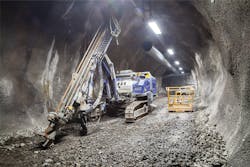Modern mining equipment, whether surface or underground, presents challenges to hose manufacturers to provide products that meet or exceed equipment’s criteria. New equipment designs require higher working pressures, larger inside diameters and compounds to handle multiple fluids. Systems that operate at higher pressures provide quicker performance, which can enhance production output at the mine site while demanding more out of hoses.
Hose offerings today are designed to serve multiple areas of operations with higher pressure ratings, better bend radiuses and abrasion-resistant covers to accomplish the most severe requirements. Mine owners are challenged daily with keeping equipment in good working order at all times; downtime is not an option. The process requires many contiguous operations going on at the same time; when one area is down, it may greatly affect other areas of the operation.
Hose is an integral part of most equipment in mines, and by design, the weak link in the system. This makes it imperative to have the best quality hose and accessories that are available on a moment’s notice to keep mines up and running. This article discusses two types of mining, surface and underground, and compares the two for hose needs.
Surface mining
Surface mining equipment requires much larger hose and fittings coverage than in underground mines. Diverse types of equipment — including scrappers, dozers, haul trucks, water trucks, hydraulic shovels and drill rigs — all have similar hydraulic needs. Typically seen are ¼-inch to 2-inch hydraulic hoses in braided and spiral constructions that cover low, medium, high and ultra-high pressure ranges.
It is important to train machine operators on the differences between each of the hoses to avoid premature failure. For example, if an operator replaced a spiral hose with a braided product it could have catastrophic results. The maintenance team must be educated on the differences between the two constructions. All too often, this incorrect substitution will occur and the next maintenance person will replace it with the same hose that failed.
The low-pressure side of the machines typically use ¾-inch to 4-inch hydraulic suction return lines and are less vulnerable to failure. Engine fleet type hoses are common for brakes, fuels, oils and high-temperature transmission lines and use reusable couplings for ends attachment, which are convenient for field replacement. These types of hoses are generally built more to an automotive standard; therefore, hose suppliers must be well-versed in finding replacements for the mine owner. Some manufacturers produce engine hoses with standard inside diameters to eliminate the need for reusable couplings; therefore, existing crimp-type couplings can be used to cover many hose styles and reduce inventories.
Hose coupling thread ends will require American standards including SAE, JIC, NPT, Boss O-Ring, Flat Face, Code 61 and Code 62 flanges. Metric ends including DIN, BST, BSPP, Komatsu and JIS may also be required. Many mine sites do hydraulic hose crimping on-site using in-house inventories and crimpers to eliminate any hose-related downtime. Many mine sites also utilize premade hoses that hang on the wall for many high-pressure or specialized lines for a specific piece of equipment. Theses hoses may require 5,000 or 6,000 psi, and liability is passed to the equipment manufacturer on assembly fabrication. In other cases, premade hoses can also be tied to warranty issues for new equipment.
Hydraulic hoses have been developed around total system pressures and constant hose product lines are common today. Using a constant hose system pressure product line either in braided or spiral construction eliminates large inventory needs, reduces purchases, reduces mix-and-match hoses and provides complete coverage to simplify hose selections. This again makes it imperative to have a well-trained customer to avoid improper hose selection.
Another important issue to consider is hose abrasion. It is noted that 95 percent of hose failures occur from outside of the hose through abrasion by rubbing on the equipment or other hoses. Different methods using various hose cover protections are used including steel spring guarding, flat spring guarding, flat spiral plastic guarding and abrasion sleeves. These all have a common purpose: hose abrasion protection. Most manufacturers today have special blended hose covers that have medium-to-high abrasion built into the covers without affecting the bend radius. Each mine site’s culture dictates what is used, e.g. abrasion sleeves on the hose or extra-tough covers.
Most hoses used at a surface operation are hydraulic in nature. But many industrial hoses are also used in shops and at the mining sites for air, water, nitrogen charging, drilling air, petroleum and water. Most mines utilize large water pumps to remove surface water from the mining site; these hoses can range in size from 3 to 12 inches in diameter and are capable of transferring water several miles. Most coupling connections are common industrial standards.
Underground mining
Slightly more than 50 percent of mining is conducted underground. Over the last several years, underground mining has become an efficient, sophisticated operation utilizing the latest technology. New processes use less manpower since the machines now do most of the work. The hose needs are slightly different in this operation and are split into several different areas of operation. The equipment used in these processes is all hydraulically operated and requires dependable hose.
- Continuous miners: This process readies the mine for the equipment used to mine and makes "rooms" for the longwall mining process. Typically, hoses rated to between 3,000 to 5,000 psi are used in this process.
- Bolters and drills: Equipment used to predrill holes for blasting and to secure roof bolts; 3,000 to 5,000 psi.
- Longwall system: Roof support shields, shear and monorail for ore production. This is the science behind economical and safe mining. It is operated with a series of hydraulic cylinders pushing on shields to hold up the roof of the mine. This requires several hoses ranging from 5,000 to 6,000 psi.
- Monorail: System to provide water, hydraulic pressure, return hoses and electrical and cabling to the long wall; 500 to 5,000 psi.
Hydraulic hose
It is important that Mine Safety and Health Association (MSHA)-approved hoses are used in the mining process. Hydraulic hoses and couplings meet or exceed MSHA requirements. Because mining can be a very abrasive process, an additional abrasion sleeve may be required on vulnerable parts of the hose assemblies that come in to contact with equipment structure or other hose assemblies. Manufacturers have developed hose cover compounds that can withstand severe abrasion to eliminate the cost of the sleeves.
The coupling ends that are utilized are JIC, NPT, O-Ring Boss and Flat Face and are commonly available. DIN, BST and BSPP metric ends are used on some systems. Also, a common coupling used in the process is a Staple-Lok or Stecko fitting to securely attach hose to machinery and other hoses. The fitting construction utilizes pins or staples into a locking collar to prevent disconnecting while in use. Typically, ¼-inch to 1-inch hoses use the single-staple system, while 1 ¼-inch to 2-inch hoses use a double-staple system for securing the coupling. Both styles are rated to 5,000 to 6,000 psi and are critical for quick changeout of damaged hose runs. Some mines like to have on-site capabilities to make assemblies along with off-the-shelf, premade assemblies for critical spares. Again, it is imperative to properly train anyone that assembles hose assemblies on-site.
Industrial hose
Several types of industrial hose are used in the mining process at every stage. Some of the most common are:
- Yellow mine spray hose: Used for firefighting and dust control; supplied in ½-inch to 3-inch sizes with working pressures to 1,000 psi.
- Rubber and PVC rock dust hose: Used for dusting of walls for illumination process.
- Split PVC cable guarding: Used as a cable protector; supplied in 1 ½ inches to 3 inches.
- Mine conduit-rubber tubing: Also used as a cable protector; supplied in 3/8-inch to 3 inches.
Several other types of hose are used as well from general service air and water hose to pressure-washing hose to ducting hose for dust and ventilation. An array of industrial hose couplings are used in this process from cam-and-groove to hammer locks to firehose connections ranging in sizes from ¼-inch to 12 inches in diameter.
Conclusion
Hose has been part of the mining process for more than 100 years and has evolved to keep up with the demands of this rigorous industry with products that continue to provide safety for mine workers while getting the job done. Hose continues to play a huge part in mining of raw materials around the world today.
Joe Lark is Motion Industries’ product manager for hose. Before his nine years with Motion Industries, Lark spent 20 years with Monroe Rubber and Plastics Supply Company (now a unit of Motion Industries), with the last 10 as president/owner. He is a past president of the National Association of Hose and Accessory Distribution (NAHAD) and is the committee lead for developing "Hose Assembly Guidelines" for NAHAD.




